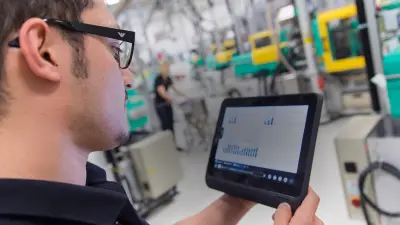Intelligent systems for the flexible factory 4.0
Flexible platforms, safe human-machine collaboration, and connectivity from the sensor to the cloud make production facilities ready for industry 4.0.
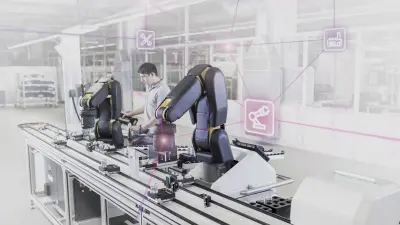
The APAS production line shows an example of the intelligent factory. The APAS production assistants support humans with simple, monotonous, or ergonomically challenging tasks, while the IT Shopfloor Solutions ensure the connectivity of the entire line.
“The APAS assistant is the first robotic system approved by the German employer’s liability insurance association for direct, safe and contactless human-machine-cooperation.”
Human and machine hand in hand
As inherently safe robotic system, the APAS assistant facilitates the direct interaction with humans without the need for a safety fence. The collaborative robot interacts with employees without any contact. This is possible thanks to a sensor skin, which surrounds the entire robot arm. As soon as the robot senses impending contact with the operator, it instantly stops, and resumes its work where it left off once the employee is no longer in its immediate vicinity.
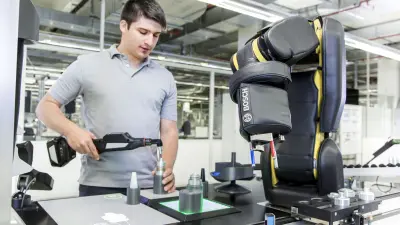
“Thanks to the user-centered development process, our solutions are tailored to the users‘ requirements.”
Perfectly tailored
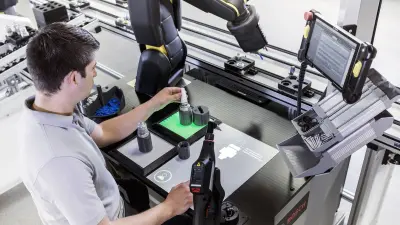
The APAS workstation is the first manual workstation with integrated, collaborative robot kinematics. It provides a joint workspace for humans and machine, which adapts to the needs of every single employee. Humans take center stage, not the robots. While the robot arm assists the employee like a third hand, the intelligent workstation provides optimum working conditions and a unique user experience. The automatic height adjustment avoids back strain, the light guide is adjusted to each employee, and instructions are projected directly onto the tabletop.
“Products are becoming more and more individual, their lifecycles are shorter, and batch sizes smaller. This calls for flexible solutions for an efficient production.”
Highly flexible
All production modules can be combined with different platforms, thus seamlessly adapting to different production concepts. For instance, the APAS assistant on a mobile platform can be employed exactly where it is needed. Thanks to intuitive operation concepts, employees can train the robot for new tasks, even without specialist programming knowledge.
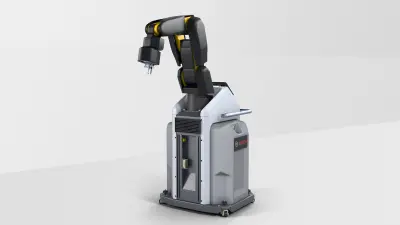
“With the APAS inspector we offer individual solutions for visual inspection and quality control — modular, reliable and ready for use quickly at all times.”
The APAS inspector doesn’t miss a thing
At the end of the production line, the modular inspection system is responsible for controlling the quality of the assembled parts via high-speed camera. Thanks to the robust 3D imaging process, the APAS inspector delivers precise results — even in rough production environments. The variable inspection modules make it possible to perform a multitude of inspection tasks.

Learning from humans

The APAS inspector can actually learn: employees show the system, which surface traces it can tolerate because they have no influence on quality, and when a part must be rejected. Employees can continuously optimize and adapt inspection parameters, even without specialist image processing knowledge. The APAS inspector learns from human experience and can successively perform quality control independently.
Maintenance with Augmented Reality
Novel diagnosis tools support staff in maintaining the machines. If a device reports a defect, the employees know where to find the fault within a very short time — thanks to Augmented Reality, and even without having to open the machine. The innovative diagnosis tool shows them step by step how to repair the device.
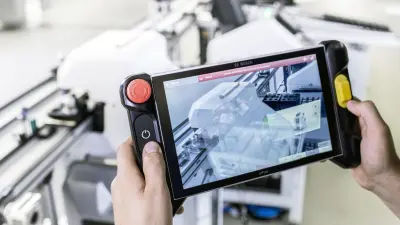
“Connectivity in the production facility supports staff in their daily work. They have access to data at any time. They can analyze and visualize this data so that they always have a good overview of the entire production.”
Fully connected — from the sensor to the cloud
Standardized interfaces facilitate communication between the assistant systems, as well as with external machines. The IT Shopfloor Solutions connect the entire line. They offer modular, scalable software and hardware solutions for the connected, intelligent factory. Production data from sensors or machine controls is collected and fed into the cloud via software services.
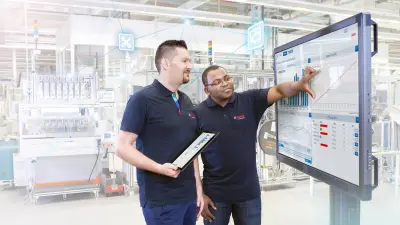
Summary
The combination of all these technologies results in a fully connected i4.0 production line, offering the highest flexibility and transparency, as well as future-proof interaction of humans, machines, and processes.


